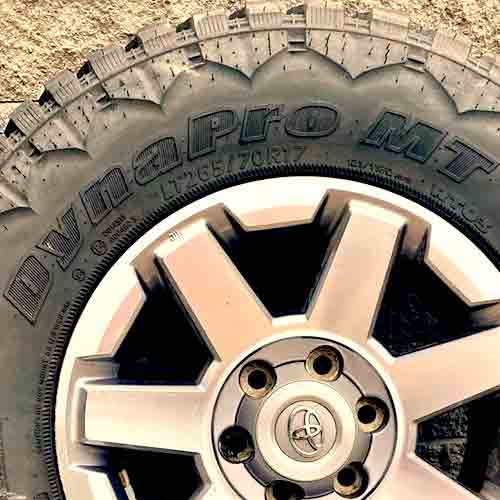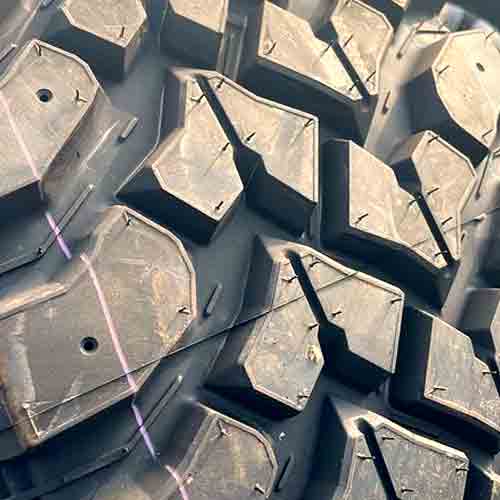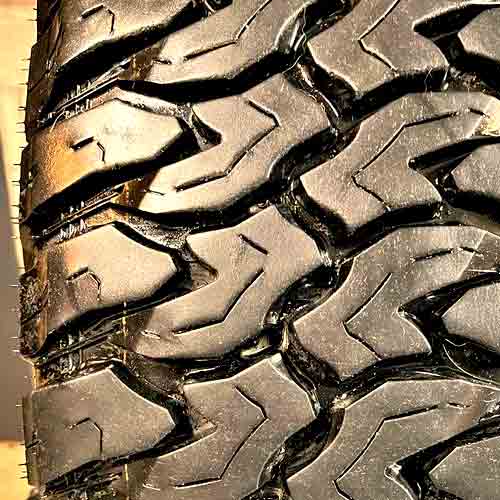Both the Hankook Dynapro MT2 and the Dynapro MT, are packed with innovative tread compounds, that provide superior off-road performance. Let’s compare the technical specifications and performance data to determine which one is the better choice for your specific needs.

Table of Contents
Tire Sizes
The Hankook Dynapro MT2 comes in 15 to 22 inches wheels, with following specs:
- Speed ratings: Q only.
- Load ratings: C to F.
- Weight range: 45 to 90 lbs.
- Tread depth: 15.5 to 18.5/32″.
- Winter ratings: None.
- Warranty: None.
Review this tire in detail: https://tiredriver.com/hankook-dynapro-mt2-review/
On the other side, the Hankook MT also offers 15 to 22 inches rim sizes. And they have following specs:
- Speed ratings: Q only (same).
- Load ratings: C to E.
- Weight range: 35 to 106 lbs (heavier).
- Tread depth: 13 to 21/32″ (larger).
- No winter ratings here as well.
- And no treadwear warranty too.
Tread Design
The Hankook Dynapro MT, while designed for challenging terrains, sports a distinct tread pattern.

So the tread design of this tire comprises of aggressive block formations, organized in 4 ribs in total. 2 of those are shoulders, and 2 are in the middle.
The central lugs are L/C shaped and exhibit sharp edges and off-set sides, increasing the tire’s grip on challenging terrains.
Moreover, these lugs have chamfered edges, thick siping slits and reinforced foundations as well. And together they make a laterally oriented structure, in combination to shoulder lugs.
The shoulder lugs are elongated, and have thick mud scoops (due to their staggered design). They don’t have a lot of features, but do have foundational supports and are studable.
And their lateral gaps have very bold stone ejectors in between.
Moreover these lugs also extend down to form thick knife shaped sidewall lugs.
The Hankook Dynapro MT2 features a less aggressive design in comparison.

This tire comes with 4 ribs in total, having smoother L or C shaped lugs in the middle ones.
Though these lugs are also edged, and contain better interlocking siping structures.
Moreover, they wrap around the shoulder lugs, to form 3 longitudinal grooves for vertical evacuation, while the shoulder tread voids provide lateral grooves with bold stone ejectors for horizontal tread cleaning.
Overall, you can say that most of the off-road traction on this tread, comes form the shoulders.
As these lugs besides having an relatively more open design, also feature staggered outer edges, and they also extend down towards the sidewalls and make thick enough lugs there.
These “sidewall lugs” mostly help when you lower down the air pressure of these tires, off-road, mostly on rocky terrains.
Dry Grip
Mud tires are typically challenged by tarmacs, due to their aggressive design, and so highway grip can be a concern, as their larger voids result in lesser rubber making contact with the road.
However, the Hankook Dynapro MT2 demonstrates commendable highway traction due to its directional lug orientations, especially compared to its predecessor.
With longitudinally aligned lugs, the tire gets to show up with shorter braking distances, as all lugs are more streamlined, favoring straight-line motion.
In comparison, the Hankook Dynapro MT’s wider tread voids can’t form similar gripping values.
Dry Handling
Just as we saw in the grip, similar scenario unfolds when considering handling. The Hankook Dynapro MT, being more voided up lacks here as well.
Its heavier structure gets to exhibits more flexing of the lugs, leading to increased understeering and oversteering, thus compromising steering response.
This is because its voided structure puts greater (weight) pressure on each tread lug, as they contact the ground.
On the contrary, the Hankook Dynapro MT2’s more uniform, lighter structure, offers lower moving inertia. This allows the tire to have one of the best handling times in the mud-terrain category.
Navigating Wet Roads
As water is incompressible, the only way the rubber can grip on the road is by readily removing water out of the tread. And that’s where grooves and sipes come in.
Though both tires offer ample grooves to channel majority of water out, providing equal resistance to hydroplaning, the MT can’t handle the remaining left over water.
These water particles has to be removed with sipes, and those are only better on Hankook MT2.
So with superior interlocking sipes, the MT2 gets to be much better here, whereas its predecessor, with missing siping shows up with relatively more slippage.
Tread Wear & Fuel Consumption
The amount of rolling resistance (which is essentially the friction between the tire and the ground), is what significantly impacts the fuel consumption.
That’s why Hankook Dynapro MT2 being a lighter tire gets to be better here.
As the tire maneuvers, its lugs keep their movement to a minimum, in other words, its tread blocks don’t waste energy in to bending, and instead that energy is utilized for the movement of the tire.
Though when it comes tread life, both tires show up with similar performance. That’s because the Hankook MT, despite having higher rolling resistance, still gets to take longer to wear down, thanks to it’s greater tread depth, and relatively stiffer rubber compound.
Ride Comfort
Ride quality is significantly influenced by a tire’s ability to absorb road vibrations. In this respect, the Hankook Dynapro MT2 excels with its flexible compound, effectively cushioning road imperfections.
Moreover the tire also does better terms of reducing tread noise.
Noise is just air particles hitting around the tread walls, and with more closed up tread voids, less noise gets generated on Dynapro MT2.
Moreover its tread also employs superior pitch sequencing technology, to further dampen down the remaining noise levels.
This variable pitch approach alternates the tread’s geometry to create varying tones, as air particles collide with the tread’s walls. These different tones then help to cancel out each other, resulting in a quieter ride.
Winter Traction
Winter performance largely depends on a tire’s ability to maintain momentum and efficient handling across various snowy conditions.
And although, aggressive off-road tires struggle on packed snow and ice, they perform reasonably well in deep snow (above 3 feet).
Same is the case with our Dynapro tires, they have powerful shoulder scoops and sidewall features that effectively plow through deep snow.
But still if you have to pick one here, go with Hankook MT2, as the tire offer slightly better snow holding abilities.
It’s tread captures snowflakes in it’s interlocking grooves, and then forms snow contact with it (which yields greater friction compered to rubber to snow contact), allowing for superior overall winter performance.
All Terrain Traction
Folks often think that mud tires are only good for mud, but that’s not really the case. They work equally well, in other terrain types too. Let’s check them out.
Muddy Terrain
In muddy conditions, it’s important to have tires with self cleaning grooves and paddle like lugs.
That’s why here the Hankook Dynapro MT remains unbeatable. If you consider it’s tread design again (by scrolling up), you’d note that its much more voided, where it’s L shaped lugs are arranged laterally.
So with more spaced apart lugs, having deeper tread voids, the tire is able to take on deeper muddy trails, while it’s laterally placed lugs act as paddles, scooping thick mud backwards, and generating forward momentum with it.
On the flip side, while the Hankook Dynapro MT2 performs well, it does not quite match the capacity of its predecessor when it comes to tackling particularly challenging muddy terrains.
On Rocks
For rocky terrains, a tire needs to offer a flexible tread and resilient sidewalls.
And following extensive testing, the Hankook Dynapro MT edges out here, as it provides softer, adhesive lugs and larger grooves, for optimal rock bite.
Moreover, although both tires have 3 ply sidewalls, the Dynapro MT still offers better protection with its thicker lugs over there.
Sandy Dunes
Sand is the only terrain, where the Hankook Dynapro MT2 is taking the lead.
The tire offers much lighter overall structure (where its heaviest size is 16 pounds lighter, comparatively).
Moreover, it’s sidewall lugs are although not as thick compared to Dynapro MT, they still cover a larger surface area over there. So with lowered air pressure, they spread out much more, allowing for greater contact meet-up with the sand.
Wrapping Up
So overall, it all comes down to this.
The Hankook Dynapro MT2 shows up with better highway traction and handling due to its directionally arranged lugs. And here its predecessor really struggles, due to its wider tread voids and heavier structure, showing up with lagging steering feedback.
Same is the case in wet conditions, the Hankook MT2 comes out superior with it’s interlocking sipes, providing both lateral and longitudinal grip, much better compared to MT.
And on snow, it’s interlocking (wrapping shoulder) lug design provide better traction capabilities, thanks to it’s snow to snow contact.
Though off-road is where the Hankook Dynapro MT takes the lead with it’s wider self cleaning grooves and robust sidewalls.
They offer much better traction on both muddy and rocky terrains.
But on sand, the tire isn’t able to offer as much performance, mostly due to its heavier weight.